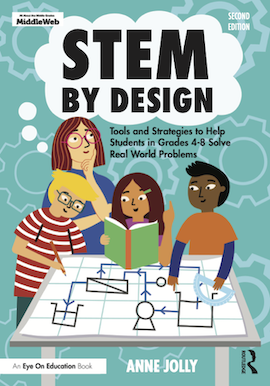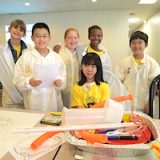Evaluating and Adapting an Existing Lesson as a STEM Project
Now that you’ve decided to lead a STEM project, what lessons are you going to use? This question arises more and more often as teachers and schools across the nation get serious about offering STEM learning experiences for their middle grades students and begin to cast about in search of worthwhile instructional material. You don’t have to reinvent the wheel, so you might cast about first for some existing STEM curricula.
As you dive into the still muddy waters of STEM curricula, remember that not all lessons you encounter will be integrated STEM lessons. Once you land on a lesson that seems to fit your needs, you need to decide whether it’s really a STEM lesson, or how you could adapt it to make it one. To help you with that decision, let’s consider what genuine STEM lessons look like.
STEM Lesson Specifications:
1. Does the lesson present a real problem (an engineering challenge)? You’re looking for lessons that will tap into students’ natural and innate curiosity and entice them to ask questions and investigate issues in their lives, communities, and even globally. (See Chapter 9: Selecting a STEM Challenge for information about choosing a meaningful problem.)
2. Can all students relate to the problem? Your class may contain students of different races, ethnicities, genders, and disabilities. Can all of them understand the problem? Keep in mind that all kids generally like working on problems that they feel make a difference. (See Chapter 6: Including Diverse Students in STEM for useful tips and information.)
3. Does the problem the lesson presents allow for several different approaches and correct solutions? As you know, STEM challenges are open-ended. They don’t have just one correct solution. Stay alert. Don’t choose lessons for your STEM classes that lead kids to discover “the one” right answer. (More information on this is also in Chapter 9.)
4. Does the lesson apply important science and math grade-level content? High quality STEM curriculum is not math and science “lite.” STEM lessons focus on reinforcing, applying, and going deeper into science and math. It’s okay if content from one subject is more heavily emphasized. (Chapter 4: Designing a STEM Project contains information about integrating science and math.)
5. Does the lesson lead students to use an engineering design process for solving the problem? By now you know that a key component of good STEM lessons is the use of an engineering design processfor approaching and solving problems. Even if the steps of the process are not actually labeled within the lesson, the lesson should involve students in using this approach to solve the challenge. (See Chapter 8: The Engineering Design Process for more information.)
6. Does the lesson feature a problem-based learning approach? The lesson highlights student ownership and choices in a risk-free atmosphere. The lesson is not prescriptive, and teachers act as facilitators who monitor and provide guidance as needed. (See Chapter 7: Leading a STEM Project for additional information.)
7. Does the lesson lead students to plan, design and construct a model or prototype? Like actual engineers, students plan, design, and build a tangible prototype they think will solve the STEM problem. Kids make the decisions about what this device will be and do; and different student teams may construct different prototypes. (See Chapter 8: The Engineering Design Process for some additional discussion on this.)
8. Is technology essential to the success of the lesson? Technology is not an add-on in STEM lessons, but genuinely necessary for completing the project. The lesson should provide opportunities for students to use digital technologies, if possible. They might use technology for research, investigation, design, communication, data analysis, and more. (For information about technology and STEM see Chapter 13: Integrating Technology.)
9. Does the lesson engage students in purposeful teamwork? Teamwork is a signature feature of all STEM projects. Be sure the project you choose, or design, specifically references student teams. (For information about teamwork and STEM see Chapter 11, Successful Student Teaming.) You might also wish to download my Student Teaming Tips from the tab on this website:
10. Does the lesson include testing the prototype, evaluating the results, and redesigning the solution to improve the outcome? Conducting controlled tests, accurately interpreting data, and drawing correct conclusions are vital skills that students need to develop. Based on valid test results, team members make informed decisions about redesigning their prototype to improve it. (See Chapter 8, The Engineering Design Process for additional discussion of these features.)

To be sure, these 11 criteria sound like an ambitious agenda for any curriculum. But remember – all lesson specifications don’t have to be in the mix in every lesson. It’s okay to select a lesson that doesn’t meet all the specifications but select an appropriate one with as many as possible. You can adjust a lesson that fits your needs and add a missing specification you consider important for your students.
Over the course of the school year, be sure to select lessons that include a mix of different specifications so kids can practice implementing all STEM components. Who knows, maybe you’ll get lucky and locate the bellwether of all projects – one containing all 11 specifications!
Want to try your hand at adapting a lesson from an online source? The Touchdown Challenge is part of an engineering challenge project developed by NASA and the PBS Design Squad back in 2008. Download the Touchdown Challenge segment here and consider what changes you might make to create a STEM challenge for your students that includes most or all of the 11 specifications. Would you like to read my assessment of the Touchdown Challenge, where I break it down specification by specification? Download my analysis here. I include tips for strengthening the STEM aspects of the challenge.
You can download the full set of NASA’s On the Moon challenges here.
Find even more adaptable lessons at the end of this MiddleWeb post.











